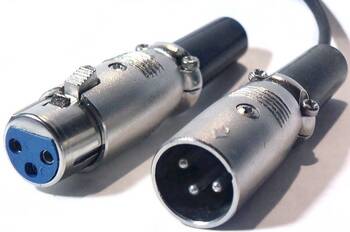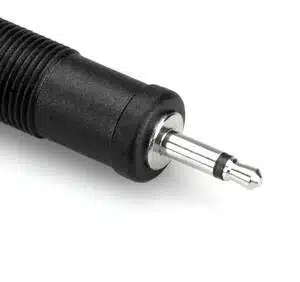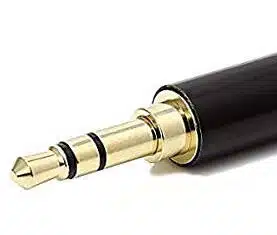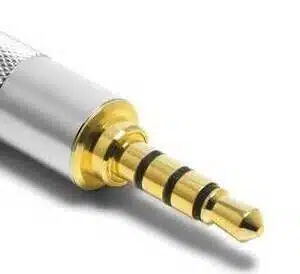XLR and 3.5mm connectors are two of the many audio connectors available today. And they are, without a doubt, part of the most used options out there. However, do you really know enough about them?
What is the difference between XLR and 3.5mm connectors? Which is the better option? And can you connect an XLR jack to a 3.5mm port and vice versa? This and more is what we’ll talk about in this article. So if this is something you’re interested in, then let’s jump right into it.
Table of Contents
What Is an XLR?

XLR is one of the popular audio connectors you will come across in the audio industry. The term XLR is an abbreviation for “External Line Return”. An XLR connector may have three or more pins. However, the XLR connector primarily used is the one with the 3-pin connector.
Due to this, whenever an XLR connector is being mentioned, it is the 3-pin XLR connector that is being referred to. Thus, a typical XLR connector is a 3-pin connector that is used in the audio and visual industries. This 3-pin connector is usually used to connect microphones and some musical equipment.
It is also used in some stage lighting equipment. This is some brief information on what an XLR is. If you are interested in learning more about XLR, you should read this article titled “XLR vs ¼ Inch”.
What is A 3.5mm Connector?
The 3.5mm connector is an electrical connector used to transmit audio signals. It is popularly referred to as the headphone jack or phone connector.
This 3.5mm audio connector was invented in the 19th century. Back then, it was purposely used on telephone switchboards. Now, it is commonly used with consumer electronic gadgets like headphones, smartphones, portable audio players, laptops, and more.
You can find 3.5mm ports on other audio devices such as mixing consoles, DACs, audio interfaces, integrated amps, and receivers. Thus, this audio equipment also allows you to connect headphones with 3.5mm connectors to them.
There are different types of 3.5mm connectors, and it can be hard to distinguish between them if you don’t know what to look out for. Let’s take a look at them.
3.5mm TS Male Connector

A 3.5mm TS male connector is a two-conductor audio connector that transmits mono audio signals through only one channel. The abbreviation TS stands for Tip and Sleeve.
This 3.5mm TS male connector is divided into two sections by a black band. The Tip refers to the small end of the pin, while the remaining large metallic body of the pin is the sleeve. The Tip is responsible for transmitting the audio signal while the sleeve serves as the ground.
3.5mm TS jacks are used for only mono audio signals. They can’t transmit stereo signals.
3.5mm TRS Male Connector

The 3.5mm TRS male connector is basically an improvement on the TS connector.
This TRS male connector is a 3-conductor audio connector. The TRS in its name stands for Tip, Ring, and Sleeve. What this means is that this connector is divided into three sections. The Tip and Ring serve as the right and left channels to transmit audio signals.
The section known as the Sleeve functions as the ground. Because there are three conductors in a 3.5mm TRS male connector, it can transmit balanced mono signals and unbalanced stereo signals.
3.5mm TRRS Male Connector

The 3.5mm TRRS connector is primarily used for headphones with a built-in microphone. You probably know the headphones used by gamers and Twitch streamers that have a microphone attached to them. Most use a 3.5mm TRRS male connector, if not all of them.
The 3.5mm TRRS male connector is a four-conductor version of the 3.5mm connector. Thus, the TRRS in its name represents the four conductors or sections of the connector.
These sections are; the Tip, Ring, Ring, and Sleeve. The Tip and two Rings are responsible for transmitting composite analog videos and stereo sound.
Even though 3.5mm connectors, in general, are primarily meant for transmitting musical sounds, the 3.5 TRRS male connectors have been designed to have microphone functionality.
Due to this, it can transmit voice signals when you speak through them. Thus, this particular 3.5mm connector is normally used in conjunction with smartphones.
Difference Between XLR and 3.5mm
Balanced/Unbalanced
All cables with an XLR connector are known to be balanced cables. This is because they primarily carry balanced audio signals. Any audio cable designed to be balanced can eliminate external noise and interferences that may try to affect the purity of the audio signal it is carrying.
What this means is that cables with XLR can preserve the cleanliness of audio signal output. They cancel out noise that may find its way into an audio signal. Thus, an output signal from an XLR cable is the same as it was when it was transmitted from its source.
Unfortunately, the same cannot be said about 3.5mm connectors and the cables they come with. This is because 3.5mm connector cables are largely unbalanced cables.
Even though the TRS male connector can transmit balanced mono signals, the stereo signals it transmits are unbalanced. Unbalanced cables cannot withstand electromagnetic interference and noise, especially when they are used for long cable runs.
Therefore, when 3.5mm connectors and their cables are used for long cable run applications, the quality of the audio output may degrade. Due to this, most professional videographers do not like using microphones that come with 3.5mm connectors for their work.
Those that use such microphones ensure that the 3.5mm cable is as short as possible to avoid the picking up of interference. If you are interested in learning more about balanced audio cables, read this article.
Locking Mechanism
An XLR connector comes with a locking mechanism that helps to ensure that connections involving XLR are tight and secure. Due to this locking mechanism, it is rare for XLR connections to get pulled out accidentally.
On the other hand, 3.5mm connectors have no locking mechanism. A 3.5mm connector is basically a pin inserted into a port. It does not have any locking mechanism to guard against accidentally pulling out.
Thus, cables with 3.5mm connectors are susceptible to being accidentally pulled out from the audio equipment they are connected to.
Build Quality
Another difference between XLR and 3.5mm connectors lies in their build quality. In general, most XLR connectors are made from relatively high-quality materials. Due to this, they do not get damaged easily. Thus, XLR connectors tend to last longer than 3.5mm connectors.
Over the years, 3.5mm connectors have gathered a bad reputation as being cheaply built. This is not surprising since most 3.5mm connectors are made from inferior materials. Thus the pins of 3.5mm connectors tend to break easily.
Which is Better: XLR or 3.5mm?
XLR connectors are better than 3.5mm connectors. Cables with XLR connectors deliver audio of much better quality than cables with 3.5mm connectors.
This is because all XLRs are balanced audio cables that carry balanced audio signals. Audio signals that are transmitted by balanced cables are not subject to electromagnetic interference and noise. Thus, the audio output transmitted by XLR cables is typically clean.
As you may already know, long cable runs are usually susceptible to external noise and interference.
Fortunately, because XLR is designed to transmit balanced audio signals, it is not susceptible to these external noises and electromagnetic interference. Thus, an XLR can be used for long cable-run applications without facing any problems.
Because the cables that come with XLR connectors are basically noise-canceling, many prefer them over 3.5mm cables.
That is why XLR cables are mostly used in professional audio and video settings and environments. Because XLR cables are balanced, they can be lengthened for more than 25 feet without being susceptible to external noise and electromagnetic interference.
As I have mentioned earlier in this article, most of the cables that come with 3.5mm connectors are unbalanced cables. Thus, they tend to pick up noise and interference when used for long cable runs.
Due to this, the audio signal they transmit in such situations tends to be of poor quality. This is the main reason why XLR comes up top over 3.5mm.
Also, the three pins of XLR connectors provide a much better and more reliable connection than that of the 3.5mm connector. Thus, connections involving XLR connectors tend to be more solid than a 3.5mm connector connection.
Can You Connect XLR to 3.5mm?
Yes, you can connect an XLR to a 3.5mm. You can connect a device with an XLR port to another device that accepts a 3.5mm connector. This can be done by using a 3.5mm to XLR adapter.
A 3.5mm to XLR adapter is a cable that is built to have a 3.5mm TRS plug at one end and two male XLR connectors at the other end. There are many different 3.5mm to XLR adapters available.
This adapter is normally used to connect 3.5mm TRS microphones to professional recording equipment that has female XLR ports.
Some of this professional recording equipment includes mixers, recorders, and camcorders. This XLR to 3.5mm adapter cable also allows you to connect your smartphone or other smart devices to a powered speaker or mixing console.
Conclusion
Generally, an XLR connector refers to a 3-pin connector that is used in the audio and visual industries. This 3-pin connector is usually used to connect microphones and some musical equipment.
On the other hand, a 3.5mm connector is a jack that is 3.5mm in size and is commonly used with consumer electronic gadgets like laptops, smartphones, mp3 players, and many others.

Hello, I’m Elijah. A writer on Geek Musician, based in Ghana-West Africa. I am a writer with a passion for research and reading. I usually spend my free time playing chess or watching movies. For more info, check out my about me page. Or read more of my articles here.
